Home > Myanmar > Mandalay
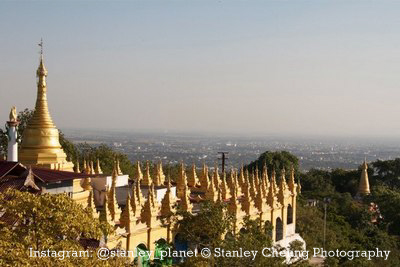
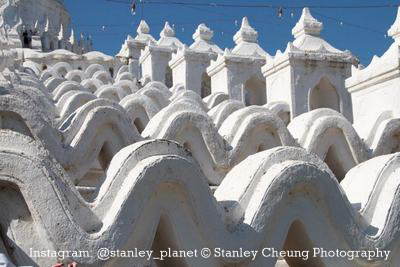
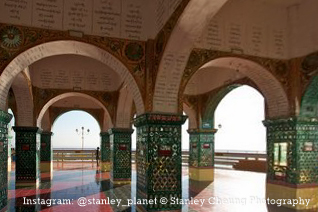
Mandalay
曼德勒
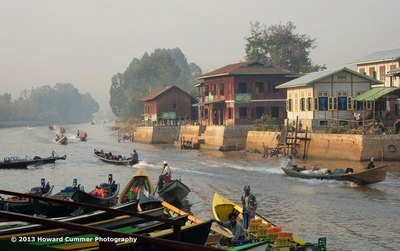 This is the last capital of Myanmar before the British took over. Historically it still has considerable cultural and religious significance. There are many inviting sightseeing excursions from this. This is the second largest city in Myanmar and is situated in the hot and dry central region of the country. Mandalay is the cultural center of Myanmar and the last royal capital. It is surrounded by other ancient royal capitals, Sagaing, Ava (Inwa) and Amarapura, which are highly interesting sightseeing destinations due to their historical and religious importance - in ancient times as well as at present. In Mandalay, you can watch traditional handicrafts being made, such as Kalaga tapestries, marionettes, bronze casting, stone and woodcarving. Mandalay also houses the most revered Buddha statue in the whole of Myanmar, the Maha Myat Muni. The Buddha Himself is said to have breathed onto the just-finished image thus giving it some of the Buddha's power. People believe that the image is somewhat "alive" and it is therefore treated with the utmost respect. Every early morning, monks and people come to the pagoda to wash the image's face and to make offerings of water, food, flowers, candles and incense.
This is the last capital of Myanmar before the British took over. Historically it still has considerable cultural and religious significance. There are many inviting sightseeing excursions from this. This is the second largest city in Myanmar and is situated in the hot and dry central region of the country. Mandalay is the cultural center of Myanmar and the last royal capital. It is surrounded by other ancient royal capitals, Sagaing, Ava (Inwa) and Amarapura, which are highly interesting sightseeing destinations due to their historical and religious importance - in ancient times as well as at present. In Mandalay, you can watch traditional handicrafts being made, such as Kalaga tapestries, marionettes, bronze casting, stone and woodcarving. Mandalay also houses the most revered Buddha statue in the whole of Myanmar, the Maha Myat Muni. The Buddha Himself is said to have breathed onto the just-finished image thus giving it some of the Buddha's power. People believe that the image is somewhat "alive" and it is therefore treated with the utmost respect. Every early morning, monks and people come to the pagoda to wash the image's face and to make offerings of water, food, flowers, candles and incense.
Mohamuni Pagoda
The center piece of this shrine is the highly venerated Mahamuni image which was transported from Mrauk U in 1784. It was believed to be of great age already at that time. The four-meter high seated image is casted in bronze but over the years countless thousands of devout Buddhists have gradually covered the figure in a 15 cm thick layer of goldleaf.
Shwenandaw Monastery 瑞南多寺院
This is a fine example of a traditional Burmese wooden monastery and a fragile reminder of the old Mandalay Fort as well.
Atumshi Monastery
Before it was destroyed by fire in 1890, it was, by all accounts, being one of the most magnificent temples in Southeast Asia. It is stil impressive to see the remains such as the stumps of the large teak pillars that once supported the roof.
Kuthodaw Pagoda 古都多佛塔
It has been dubbed "the world's biggest book in the world" built by King Mindon after the Fifth Buddhist Council. It contains the entire Buddhist canon inscribed on its 729 marble stone slabs. Each slab is housed in it is on the little stupa.
Mandalay Hill
This is a favourite place for tourists to watch the sunset. This hill, 230 meters high, is the only real vantage point over the flat plains that otherwise surround Mandalay. Various statues, shrines and Buddhas occupy the hillsides and if you wish you can choose to walk to the top via pleasantly covered walkways rather than to take motor transport.
Mandalay Fort
This is an imposing walled palace built by King Mindon Min in 1857. The royal palace within the fort was burned out during fighting between the occupying Japanese and the advancing British and Indian troops in WWII. It has been largely reconstructed in recent years. Its ground can now be visited as a museum.
Amarapura
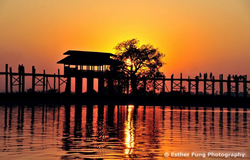 This is located 11km south of Mandalay. It was the capital city in the late 1700's and in the mid of 1800's.
This is located 11km south of Mandalay. It was the capital city in the late 1700's and in the mid of 1800's.
U Bein Bridge 烏本大橋
It was constucted in 1849, the material quallity completely selects the superior teak. Now it has more than 160 years of history. This bridge stretch across on the Taungtaman Lake. Tourists like to see that boatmen are padding the boat by means of pole on the graceful lake. At this bridge people to admire the sunset . Tthis is now the longest teakwood span in the world and is also named as the sweetheart bridge.
Mahagandayon Monastery
This is a school for young monks where we visit inside and see the daily living activities.
Mingun 敏貢鎮
This is a small town where is located 11 km upriver from Mandalay on the western bank of the Ayeyarwaddy River. It is noted for the Mingun Paya, a huge unfinished pagoda and a gigantic90-ton-bell - the largest uncracked ringing bell in the world. The 45 minutes boat trip to Mingun is a very pleasant way to see the life along the Ayeyarwaddy River.
Inwa/Ava 茵瓦古城
Ava lies 20 km south west of Mandalay. It was founded by the Shan king Thadominbya in 1364. It remained the royal capital for almost 5 centuries. Visitors cross the river on a ferry and ride around the sites of Ava in a pony cart and visit Bagaya.
Bagaya Monastery
This is one of the largest and most active of Myanmar's wooden monasteries with many rare works of arts and over 400 Buddha statues.
Ruins of old fortress
Farms, villages, monasteries, and ruined zedis are scattered around the area within the old city walls.
Maymyo (Pyin Oo Lwin) 彬伍倫
This one-time British hill town hideaway, about 2 hours drive from Mandalay, offers cool weather, eclectic architecture and stagecoaches. The town dates from the early 20th century and its main street is part of the famous Burma Road, an important route that leads north to the trading town of Lashio and beyond to the Chinese border. The street is an interesting place to walk about, lined with a mishmash of building styles; iron grillwork, balconies, chimneys and wood-carved decorations accent the architecture. The town's clock tower, the Purcell Tower with its Big Ben chime, is said to be a present from Queen Victoria, identical to one in Capetown, South Africa. Close to Pyin Oo Lwin are several natural attractions, waterfalls and caves.
Peik Chin Myaing Cave
It houses many Buddha images, and some models of Myanmar's most revered pagodas. The cave lies in a beautiful setting with some waterfalls around. It is a favourite weekend destination for local tourists.
National Kandawgyi Botanical Garden
The garden was founded back in 1915, is home to a large variety of trees and flowers from Myanmar and abroad as well as numerous birds.
Maymo Market
The region is a center for growing many "English" vegetables which need colder growing conditions. For example, strawberries in season (Feb-March) are cheap and delicious.
Monywa 蒙雅市
Monywa is about 140 km to the west of Mandalay is a commercial centre of the Chindwin Valley. Monywa serves as a major agricultural trade center for the Chindwin Valley. There is also a crater lake near the town which measures 5,363 meters in circumference and is set amidst lush scenic surroundings.
Thanboddhay Paya
is the major attraction for visitors. It has 845 smaller stupas surrounding the richly decorated central stupa. It was first built in 1303 and is said to enclose more than 7,350 relics and other holy materials.
Po Win Daung Caves
located just across the Chindwin River and reached by ferry. The caves are famous for their Buddha statues, mural paintings and woodcarvings. There are quite a few legends about the caves, related mostly to Nats (the Myanmar spirits). There are supposed to have been over 400,000 Buddha images caved out in the caves.
Sagaing 實皆
The ancient capital of Sagaing lies 21 km southwest of Mandalay on the west bank of the Ayeyarwaddy River. The Sagaing Hills offer famous religious retreats where monks and nuns go for study and meditation in over 400 monasteries. Nearby is Ywataung Village known for its silver craftsmen.
Ponya Shin Zedi
On Sagaing Hill with a number of other zedis, it was constructed in 1312 and offers an outstanding view of Sagaing.
Kaungmudaw Pagoda
This is best known of Sagaing stupas, this is a huge whitewashed edifice with a dome rising 46 meters. This zedi was built in 1636.
|
|---|
Newsletter Subscription: 訂閱最新旅遊資訊
Site Map · Privacy Policy 私隱政策(只附英文版)
© 2020 Exotic-Holidays.hk · All Rights Reserved.
![]()